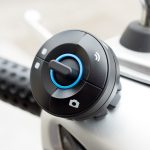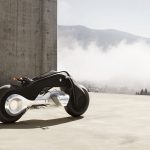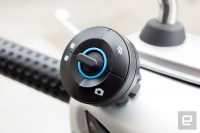BMW Motorrad brings the connected future to motorbikes
BMW Motorrad brings the connected future to motorbikes

The future of connected vehicles is gradually becoming reality. It’s an evolutionary process that relies on consumer support and legislative change as our populations must not just accommodate but transform their mindset to a new way of travel.
Given these challenges, I was excited to speak with Head of Design at BMW Motorrad, Edgar Heinrich, following the release of the BMW Motorrad VISION NEXT 100.
Unlike the gradual, cautious approach to connected vehicle designs of other companies, Heinrich and his team were given carte blanche to create a motorcycle for the future, specifically the 2040s, in honor of BMW’s 100th anniversary.
It’s one in a series of BMW concepts that aim to anticipate where its future vision is going, and how incorporating new technologies and connectivity features will change the driving experience.

The bike on first glance appears like something out of a manga television series or sci-fi program. The design is minimalistic with a nod to 1920’s aesthetics. The bike and its’ accompaniments have several distinctive features that center around the notion of safety first. The bike is self balancing through a system that uses gyroscopes to keep the bike upright (including when stopped or parked). Heinrich notes that many people are reluctant to ride bikes because riding is hard too learn or that they will find the bike too hard to upright if it falls over and this makes riding more accessible.
The bike incorporates BMW’s intelligent eCall system and provides a “digital companion” through which “The bike has the full range of connected data from its surroundings and a set of intelligent systems working in the background, so it knows exactly what lies ahead.”
An accompanying visor acts as a virtual display, projecting the ideal riding line onto the road. “This provides beginners with feedback on their progress, as well as challenging experienced riders.” These smart glasses span the wearer’s field of vision and are controlled by eye movements.
The display is similar to that in an aircraft cockpit. It shows the current angle of lean and the ideal line. If there is any deviation, the rider can correct this. If the rider fails to react or does so too late, the motorcycle corrects itself. Looking up will have a rear view mirror function. If the rider lowers his gaze a little below the normal viewpoint, a menu opens where they can trigger each function using finger gesture control.
If they lower their gaze even more, the map view opens, showing the rider their selected route. Vehicle to Vehicle communication enables riders to connect and alert fellow riders of any road changes, heavy traffic etc.

It’s worth stressing that the bike is not self-driving in the traditional sense with the exception of the safety features that fall into operation if the driver is at risk. Heinrich explains, “No one is interested in a self-driving bike where you just sit there, it’s about exploring and expanding the pleasure that riding gives that riding and optimizing that experience.” Rather, it provides a connected experience that is safe and enjoyable.
The helmet is notably absent
Much attention by bike enthusiasts has been paid to the fact that the bike is designed with the connected glasses instead of a smart helmet. Heinrich explains that “We’ve worked to create a bike that is able to be more protective than anything we’ve created before. A user is able to focus on the pleasure of the open road, the wind in their hair, the noise and feeling of the bike instead of being encumbered by a heavy protective helmet and clothing.”
It’s worth considering that BMW have already prototyped a smart helmet, the Head Up Display Helmet (HUD Helmet), which was revealed at CES earlier this year. It enables the projection of data directly into the rider’s field of view. This means that the rider no longer has to glance at the instrument panel and thus is able to concentrate fully and without distraction on the road traffic.
All displays are freely programmable; ideally, to provide the best-possible support for rider safety, only information that is helpful and relevant to the current situation should be displayed to the rider at any given moment. The display options comprise safety-relevant information including, data relating to the technical status of the motorcycle, such as tire pressure, oil level and fuel level, travel speed and selected gear, speed limit and road sign recognition, plus warnings of impending dangers.
Connected helmets have a short but chequered history with the two companies at the forefront of their development having crashed and burned. Skully went bankrupt. Fellow start-up NUVIZ have changed teams and countries. Despite successful crowdfunding in late 2013, backers are still waiting for their product.
Connected but relevant to the consumer and their environment?
As connected vehicles increase in expanding their share of the road, the role of the motorbike is more important than ever. Many other vehicles are unsuitable for older urban cities where limited parking, narrow roads and cobblestoned winding terrain make car usage impractical.
Additionally, motorbikes are far more commonplace outside Europe and America, particularly in India and Asia where their usage exceeds that of cars.
The creation of the bike is something of a designer’s dream. As Heinrich explained ” We are usually designing 5-10 years into the future and to be able to do something so forward thinking was just amazing.”
What’s in store next? Heinrich and his team have received great feedback in the creation of the Motorrad VISION NEXT 100 and the team’s enthusiasm means they “could have easily developed a series of 6 great bikes”. As connected vehicles ride into our cities, this just might happen.

The post BMW Motorrad brings the connected future to motorbikes appeared first on ReadWrite.
(25)






